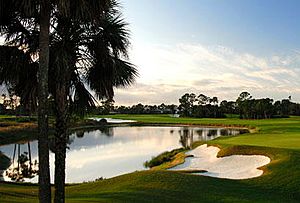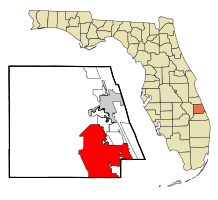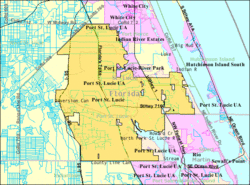Port St facts for kids
Quick facts for kids
Port St. Lucie, FL
|
|
|---|---|
| The City of Port St. Lucie | |

PGA Golf Club, located in Port St. Lucie
|
|
| Motto(s):
A City for All Ages
|
|

Location in St. Lucie County and the state of Florida
|
|

U.S. Census Map
|
|
| Country | United States |
| State | Florida |
| County | St. Lucie |
| Incorporated | April 27, 1903 |
| Area | |
| • City | 117.0 sq mi (198.6 km2) |
| • Land | 115.9 sq mi (195.6 km2) |
| • Water | 1.1 sq mi (3.0 km2) |
| Elevation | 16 ft (5 m) |
| Population
(2010)
|
|
| • City | 164,603 |
| • Estimate
(2015)
|
179,413 |
| • Rank | US: 142nd |
| • Density | 2,056/sq mi (794/km2) |
| • Urban | 376,047 (US: 101st) |
| • Metro | 438,095 (US: 116th) |
| • Demonym | Pizzulean |
| Time zone | UTC-5 (Eastern (EST)) |
| • Summer (DST) | UTC-4 (EDT) |
| FIPS code | 12-58715 |
| GNIS feature ID | 0308089 |
| Website | City of Port St. Lucie |
Port St. Lucie is a large city in St. Lucie County, Florida, United States. It's the most populated city in the county. In 2010, about 164,603 people lived there. The city grew very quickly in the 2000s. By 2015, its population reached 179,413, making it even bigger than Fort Lauderdale at that time. Port St. Lucie is part of a larger area called the Port St. Lucie Metropolitan Statistical Area, which had over 438,000 residents in 2013.
Contents
History of Port St. Lucie
In the 1950s, Port St. Lucie was mostly empty land south of White City. There was a small fishing camp, a few farms, and some businesses near US 1.
How the City Started
In 1958, a company called the General Development Corporation (GDC) bought a huge area of land. They spent $50 million to buy the River Park development and about 40,000 acres (16,000 ha) along the North Fork of the St. Lucie River. In 1959, GDC built the first bridge over the St. Lucie River. This bridge made it much easier for cars to get to Port St. Lucie.
By February 1961, there were 250 homes in this new area. GDC asked the state government to make 70 square miles (180 km²) of land, including the River Park area, into the City of Port St. Lucie. However, the people living in River Park decided not to join the new city. Port St. Lucie officially became a city on April 27, 1961. This happened when House Bill No. 953 was passed by the state legislature and approved by Florida Governor C. Farris Bryant.
Growth and New Communities
In the early 1990s, another company called Core Communities (CC) bought land and started planning a new area called St. Lucie West. They soon realized this area was in a great location. So, they decided to build more than just homes. They added business areas, entertainment spots, and places for fun. This brought about 7,000 new jobs to the city, which helped Port St. Lucie grow a lot in the early 2000s.
In 2006, Core Communities began building their newest community, called Tradition. It was designed to look like a town from the 1950s. The town center, Tradition Square, hosts many events all year. Tradition was also chosen for HGTV's Green Home in 2009 and was named one of America's top 100 communities.
Recent Developments
Around 2007, the housing market faced some challenges, and more people lost their jobs. To help the city, the county government thought about asking for emergency funds. This money would be used for building projects like research parks, new roads, and other important improvements.
In 2008, Tradition and Core Communities welcomed the Florida Center of Innovation. This is a research center and campus that has a building for two important science companies: the Torrey Pines Institute for Molecular Studies and the Vaccine & Gene Therapy Institute. This campus is expected to create more than 30,000 jobs in Port St. Lucie.
Population and People
| Historical population | |||
|---|---|---|---|
| Census | Pop. | %± | |
| 1970 | 330 | — | |
| 1980 | 14,690 | 4,351.5% | |
| 1990 | 55,866 | 280.3% | |
| 2000 | 88,769 | 58.9% | |
| 2010 | 164,603 | 85.4% | |
| 2015 (est.) | 179,413 | 9.0% | |
|
|
|||
Port St. Lucie has grown a lot over the years. In 2010, the city had 164,603 people living in 70,877 homes. About 14.1% of these homes were empty.
In 2000, about 31.6% of homes had children under 18. Many homes were married couples living together (61.8%). The average home had 2.60 people, and the average family had 2.94 people.
The city's population is diverse. In 2010, about 61.6% of people were non-Hispanic white. About 15.6% were non-Hispanic black, and 17.6% were non-black Hispanic. Other groups included Asian, Native American, and people of two or more races.
Languages Spoken
In 2000, most people in Port St. Lucie (88.05%) spoke English as their main language. Other languages spoken included Spanish (6.59%), Italian (1.34%), French (1.00%), German (0.60%), and Haitian Creole (0.50%). Overall, about 11.94% of the people spoke a language other than English at home.
Geography and Climate
Port St. Lucie covers a total area of 198.6 square kilometers (76.7 sq mi). Most of this area, 195.6 square kilometers (75.5 sq mi), is land. The rest, 3.0 square kilometers (1.2 sq mi), is water.
Climate in Port St. Lucie
Port St. Lucie has a warm humid subtropical climate. This means it's usually warm and humid, almost like a true tropical climate. Summers are hot, with high temperatures often in the low 90s Fahrenheit (around 32-34 Celsius). Winters are mild to warm, with average high temperatures in the 70s Fahrenheit (around 21-26 Celsius). The city gets about 53.5 inches (1359 mm) of rain each year.
Port St. Lucie has been directly hit by strong hurricanes. Hurricane Frances (a Category 2 storm) hit on September 4, 2004. Just a few weeks later, Hurricane Jeanne (a Category 3 storm) hit on September 26, 2004. On October 24, 2005, Hurricane Wilma (a Category 3 storm) also hit the city directly.
| Climate data for Port Saint Lucie, Florida | |||||||||||||
|---|---|---|---|---|---|---|---|---|---|---|---|---|---|
| Month | Jan | Feb | Mar | Apr | May | Jun | Jul | Aug | Sep | Oct | Nov | Dec | Year |
| Record high °F (°C) | 89 (32) |
90 (32) |
92 (33) |
97 (36) |
98 (37) |
101 (38) |
101 (38) |
98 (37) |
99 (37) |
96 (36) |
92 (33) |
89 (32) |
101 (38) |
| Mean daily maximum °F (°C) | 74 (23) |
75 (24) |
79 (26) |
82 (28) |
86 (30) |
90 (32) |
92 (33) |
91 (33) |
90 (32) |
86 (30) |
81 (27) |
76 (24) |
83 (28) |
| Mean daily minimum °F (°C) | 51 (11) |
52 (11) |
56 (13) |
61 (16) |
67 (19) |
71 (22) |
72 (22) |
72 (22) |
72 (22) |
67 (19) |
60 (16) |
54 (12) |
63 (17) |
| Record low °F (°C) | 23 (−5) |
28 (−2) |
26 (−3) |
33 (1) |
45 (7) |
56 (13) |
64 (18) |
61 (16) |
60 (16) |
42 (6) |
31 (−1) |
26 (−3) |
23 (−5) |
| Average precipitation inches (mm) | 2.7 (69) |
2.9 (76) |
3.3 (83) |
2.8 (70) |
4.4 (111) |
5.8 (148) |
5.8 (147) |
6.4 (161) |
7.8 (198) |
5.8 (148) |
3.5 (89) |
2.3 (58) |
53.5 (1,359) |
| Source: Weather Channel | |||||||||||||
Transportation in Port St. Lucie
Port St. Lucie's transportation is managed by the St. Lucie Transportation Planning Organization (TPO). This group plans and funds transportation projects using state and federal money. The TPO Board is made up of elected officials and representatives from local school and transit groups.
The city's bus system started in the 1990s, offering rides when people called for them. Later, it grew into a system with set routes and stops. In 2002, funding was approved to expand the bus service to Martin County, and it became known as the Treasure Coast Connector.
Major Highways
Port St. Lucie has several important highways that connect it to other parts of Florida.
 Florida's Turnpike (State Road 91) is a toll road. It's the only toll road in St. Lucie County. The Turnpike has two exits within Port St. Lucie: Port St. Lucie Boulevard (SR 716) and Becker Road. It helps people travel north to Orlando and southeast to Miami.
Florida's Turnpike (State Road 91) is a toll road. It's the only toll road in St. Lucie County. The Turnpike has two exits within Port St. Lucie: Port St. Lucie Boulevard (SR 716) and Becker Road. It helps people travel north to Orlando and southeast to Miami.
 Interstate 95 (State Road 9) runs through the western part of the city. It has six lanes and connects Port St. Lucie to major cities like Miami and Jacksonville. Some exits in the city include Midway Road, St. Lucie West Boulevard, Crosstown Parkway, Gatlin Boulevard/Tradition Parkway, and Becker Road.
Interstate 95 (State Road 9) runs through the western part of the city. It has six lanes and connects Port St. Lucie to major cities like Miami and Jacksonville. Some exits in the city include Midway Road, St. Lucie West Boulevard, Crosstown Parkway, Gatlin Boulevard/Tradition Parkway, and Becker Road.
 U.S. 1 (State Road 5) runs almost parallel to Interstate 95. This highway stretches from Key West all the way to Jacksonville, where it goes into Georgia. In Port St. Lucie, it runs from Lennard Road to Midway Road.
U.S. 1 (State Road 5) runs almost parallel to Interstate 95. This highway stretches from Key West all the way to Jacksonville, where it goes into Georgia. In Port St. Lucie, it runs from Lennard Road to Midway Road.
Sports in Port St. Lucie
Port St. Lucie is a great place for sports fans! It's the home of the New York Mets for their spring training. The city also hosts the St. Lucie Mets team in the Florida State League and the Mets' rookie team in the Gulf Coast League. All these teams play at First Data Field.
The Treasure Coast Galleons, a semi-pro soccer team, also play in Port St. Lucie. The city has two youth soccer clubs, Mako Soccer Club and Port Saint Lucie Soccer Club, which offer both fun and competitive play.
Golf is also popular here. The PGA Village is a large golf complex with 54 holes, a learning center, and a history center. In 2007, the city hosted its first ever PGA Tour Event, the Ginn Classic at Tesoro.
Port St. Lucie is also proud to be home to the 2009 and 2011 National Champions in Pop Warner Little Scholars Football. The 2009 Jr. Midget team had a perfect season, winning all 16 games and the Pop Warner National Championship at Disney's Wide World of Sports Complex. The 2011 Jr. Peewee team also had an amazing season, winning all 17 games and their National Championship.
Education in Port St. Lucie
Port St. Lucie is part of the St. Lucie County Public Schools district. The city has many schools for students of all ages. There are six elementary schools, seven schools that teach both kindergarten through 8th grade, and three high schools. The public high schools are Port St. Lucie High School, St. Lucie West Centennial High School, and Treasure Coast High School.
For students who want to continue their education after high school, Port St. Lucie has three colleges: Indian River State College, Barry University, and Keiser University.
Government in Port St. Lucie
The City of Port St. Lucie is run by a City Council and a City Manager.
City Council
- Mayor Gregory J. Oravec
- Vice Mayor Linda Bartz - District 1
- Councilwoman Michelle Lee Berger - District 2
- Councilwoman Shannon M. Martin - District 3
- Councilman Ron Bowen - District 4
City Manager
- Jeffery Bremer
Notable People from Port St. Lucie
- Rick Ankiel, Professional Baseball Player
- Mario Bencastro, Salvadorian novelist
- Michael Brantley, Professional Baseball Player
- Megan Fox, American Actress
- Ace Hood, Hip-Hop Artist
- Vanilla Ice, Hip-Hop Artist
- Larry Sanders (basketball), Professional Basketball Player
- Fabrizio Scaccia, Professional Football Player
- Din Thomas, UFC Fighter
- Matthew Underwood, American Actor
- Mickey Wright, LPGA Hall of Fame
- Davia Martin, Professional Princess
Port St. Lucie in Popular Culture
A made-up version of Port St. Lucie is the setting for a part of the Japanese manga and anime series JoJo's Bizarre Adventure called Part 6: Stone Ocean.
Images for kids
 |
Unincorporated St. Lucie County | White City, River Park | Fort Pierce |  |
| Okeechobee | St. Lucie Inlet | |||
| Indiantown | Palm City, St. Lucie River | Jensen Beach, Rio |


